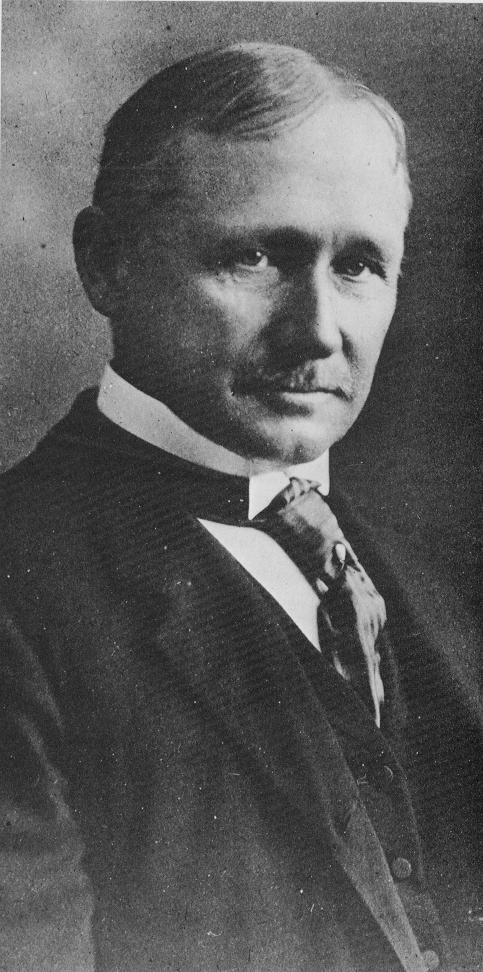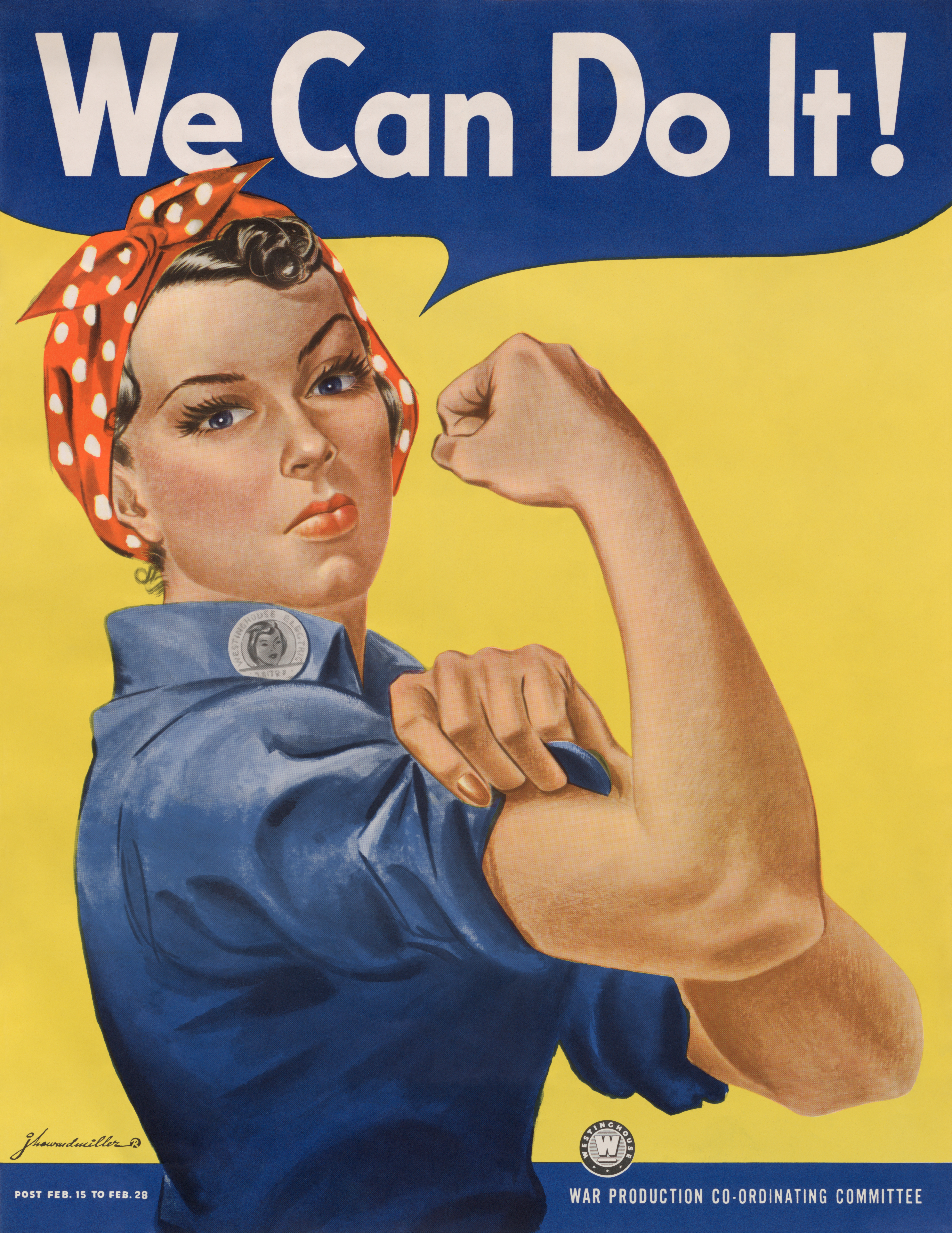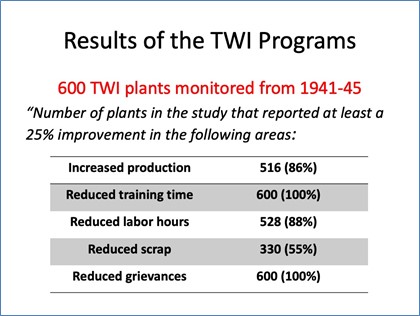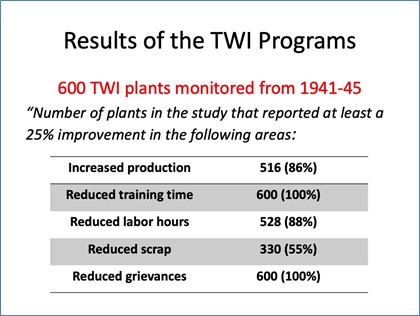A Brief History of TWI
Jeff Griffiths, FCMC CTDP
Training Within Industry (TWI) is the single most powerful system of training ever devised. With so many “flash-in-the-pan” and “flavour-of-the-month” training gimmicks out there, I thought it would be helpful to understand just where TWI came from. Here’s a brief history:
To understand TWI, you need to go back…way back… to the dawn of the 20th Century, and the work of Frederick Winslow Taylor.
1911 – Taylor and “Scientific Management”
Frederick Winslow Taylor was a mechanical engineer who is generally considered as the father of scientific management. He believed that there was one ‘best’ way to perform any given task, and this way could be discovered through scientific study. Once the best way was discovered, workers could be selected and trained in the best way, resulting in increased productivity. One of the key aspects of Taylor’s approach was the now infamous “time and motion study”, where workers performed tasks against the stopwatch while being observed to determine wasted or non-productive movements, which would then be eliminated to increase productivity.

While Taylor’s obsession with the time/motion study may be suspect in today’s context, the underlying principles are clear: there is a ‘right’ way to do a job, one that is the most efficient use of resources and which produces the highest output for the resources applied. If everyone follows this method, then measures of safety, quality and productivity will rise. This “scientific” approach laid an early foundation for what would evolve to become TWI.
Where Taylor was mistaken was in his belief that managers and not workers were best suited to determining what these ‘best’ methods were. In Taylor’s scientific management world, there were an awful lot of managers (overhead) involved in making sure plants run efficiently. In a lean environment, non-value-added work is eliminated as waste – so there are far fewer managers, and workers are in control of the work they perform.
The other problem with the Taylor method is that it significantly discounts the role of the worker. There was a need to bring the human factor into the equation.
1907-1930s- Frank and Lillian Gilbreth
Frank Gilbreth was a successful bricklayer and building contractor who had been working on increasing efficiency on job sites prior to meeting Taylor in 1907. He devoted himself full time to the advancement of scientific management from about 1910 on. His wife Lillian held a PhD in Psychology, and was equally involved in promoting scientific management. Although the Gilbreth’s initially were proponents of Taylor’s rigorous approach to scientific management (they were instrumental in forming the Taylor Society in 1910), they moved beyond Taylor’s obsession with the time aspects of work and focused instead on the motions needed to accomplish tasks. They also included the human perspective, and the need for worker satisfaction as a component of productivity. They designed systems to ease worker fatigue, and began what we would now call “ergonomics”. This inclusion of the needs of the worker is a critical component of the TWI methods.
More on Frank and Lillian Gilbreth here: https://www.economist.com/news/2008/09/05/frank-and-lillian-gilbreth
1919 – Charles R. Allen, The Instructor, The Man and the Job
The need to rapidly produce ships for the First World War meant an urgent requirement to train workers for the ship building industry. The Emergency Fleet Corporation of the United States Shipping Board initiated a training program to increase the number of shipyard workers to 10 times the current number, and they engaged Charles R. Allen, a vocational instructor from Massachusetts, to run the training program. Allen’s 4-step system for training new workers – Show, Tell, Do, Check – and his method for breaking down a job into a series of steps for training (similar to the Gilbreths motion study analysis) was documented in his 1919 book “The Instructor, The Man and The Job”. The 4-step method clearly formed the basis for the TWI programs developed over 20 years later.
You can read an online copy of Allen’s book here: https://archive.org/details/instructormanjob00allerich
1940 – 1945: The Training Within Industry Service

As America entered WWII, thousands of skilled workers joined the military, and this created a critical need to rapidly train a new, non-traditional workforce to ensure war production was maintained. The US government organized the Training Within Industry Service to provide guidance and training to companies. The leaders of this organization (Channing Rice Dooley (Director), Walter Dietz (Associate Director), Mike Kane and William Conover (Assistant Directors) – often referred to as “The Four Horsemen” of TWI) were familiar with Charles Allen’s approach from WWI, and they further developed the methods into the three programs we know as the J-programs:
- Job Instruction (to teach supervisors and experienced workers how to train new workers rapidly);
- Job Methods (to allow teams of workers to improve the way work is performed);
- Job Relations (to teach supervisors how to deal with workers and manage issues in the workplace); and
- A 4th program called Program Development (aimed at helping training organizations within companies effectively support efforts to solve production problems through training).
The TWI programs were implemented in over 16,000 organizations, and well over 1 million supervisors were trained in the TWI methods. The programs were used in the US, and also in Canada and the UK.
The success of the programs in increasing war production and creating a new workforce literally from scratch remains as one of the most significant achievements in the history of industrial and vocational training – here are some results from the 1945 TWI Report, based on a sample of 600 plants monitored from 1941 to 1945:

<CLICK HERE TO DOWNLOAD PUBLIC DOMAIN PDFs OF THE ORIGINAL TWI J-PROGRAM MANUALS>
Post War (1945-1955): TWI Foundation and TWI Inc.
Following the surrender of Japan in September of 1945, the TWI Service was shut down. As troops returned home and to the jobs they’d left behind, the TWI programs disappeared from US industry. However, the need to rebuild and revitalize industries in the former Axis countries, particularly Japan, led to the hiring in the early 1950’s of TWI Inc, led by a former TWI instructor (Lowell Mellon) to train Japanese companies in the TWI programs. The original heads of the TWI Service (Dooley, Dietz, Kane and Conover) founded the TWI Foundation around the same time as a consortium of companies that practiced the TWI methods – what we would now call a “community of best practices”.
The TWI programs were embraced by a number of Japanese companies, including Toyota.
1950’s to present: Toyota, Lean Manufacturing, and the re-emergence of TWI
Toyota incorporated much of the TWI programs into what became the Toyota Production System, and lean manufacturing. The core of the TPS is continuous improvement and respect for people. When you look at the processes and values expressed in the TPS, what one finds is the unmistakable imprint of the TWI programs:
- JI is at the root of standard work and individual proficiency of all workers
- JM is at the root of kaizen and the relentless push for improvement. The JM process emphasizes the work of what we now call ‘kaizen teams’ where managers are involved in, but not in control of, incremental improvement efforts that are initiated and managed by the people doing the work.
- JR is at the root of respecting the people who add value to the customers’ products
As North American industry tried to learn how Toyota managed to achieve such impressive results, these vestiges of the WWII TWI programs became apparent. When Toyota was developing the New United Motor Manufacturing (NUMMI) joint venture with General Motors in the 1980’s, they produced the original TWI manuals they had been trained with back in the 1950’s.
The latest work in TWI involves using these proven programs for rapid skills development, skills transfer, and structured apprenticeship training.
It took awhile (almost 70 years!), but TWI has finally come home.
<CLICK HERE TO DOWNLOAD PUBLIC DOMAIN PDFs OF THE ORIGINAL TWI J-PROGRAM MANUALS>
Read With Us
If you found this information useful, please subscribe to be notified for our next great post.
It’s amazing how TWI has had a profound impact on workforce development and efficiency over the years. How are TWI…
An excellent read that will keep readers – particularly me – coming back for more! Also, I’d genuinely appreciate if…
Thanks Dirk – as the technology matures the key for professional services is really going to be integrating the generative…
Interesting discussion – are there ideal tools and systems that can store and retrieve information faster than a lot of…
Hi Claude, thanks for your comments. We think there’s no single right way to do it… the important thing is…








It’s amazing how TWI has had a profound impact on workforce development and efficiency over the years. How are TWI principles being adapted for modern workplaces, especially with the rise of remote work?